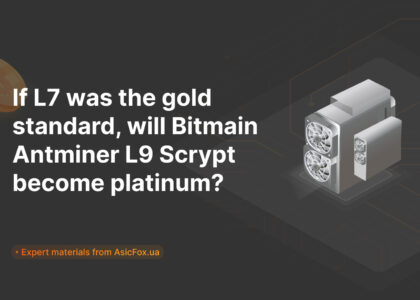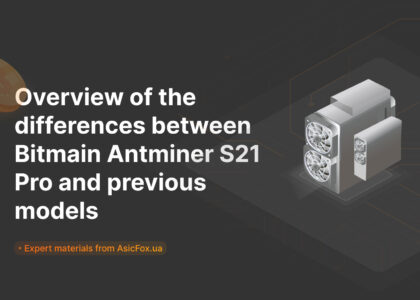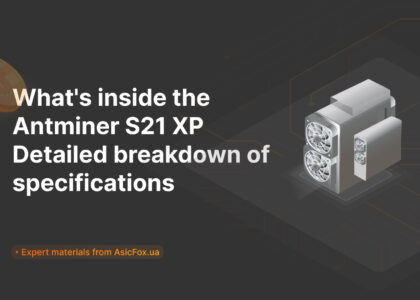In simple terms – cryptocurrency mining, what is it?
Cryptocurrency has become an integral part of our lives, and it is spreading even further across the world, no longer being an unusual phenomenon. Teachers, children, and almost every segment of society are now aware of cryptocurrency. By 2025, Ukraine already has 3.8 million active crypto wallets, and this is only counting exchange wallets, not including cold or hardware crypto wallets. Mining is still accessible to almost every segment of society, from home-based to industrial mining. Next, we will explore what cryptocurrency mining is in all its scales and aspects.
Mining – is it simple or (not) complicated?
First, what is mining? In simple terms, mining is a calculation performed by electronic equipment over the internet, for which a reward is received. To put it a bit more complexly, mining is the calculation of mathematical problems performed by equipment to confirm human calculations and record them in the blockchain, an immutable ledger. By joining large groups (pools), miners calculate colossal amounts of information and receive rewards depending on how powerful their equipment is in terms of computational ability. This is how the reward equivalent, cryptocurrency coins, is obtained. Typically, video cards and ASIC miners are used for calculations because they offer the best hash rate to energy consumption ratio. This is why miners are called miners—they literally “mine” this cryptocurrency from the global supply, which, by the way, is not infinite and has certain limits. This is one of the reasons why cryptocurrency increases in value. Therefore, to be successful, you need to be productive, and to be productive, you need the best equipment.
Mining terminologies you should know:
Like any field, mining has specific terms. These terms are used almost everywhere in this niche. Here is a list of the most common terminologies:
-
Blockchain – or “blockchain,” is an immutable digital ledger (network) where all cryptocurrency transactions are recorded. It operates thanks to those very ASIC miners and video cards. They ensure the operation of the blockchain.
-
Hash – or “hash,” is a specific set of characters, usually a string of numbers and letters, generated by encrypting data recorded in the blockchain. It is primarily used for security and as a specific algorithm for a particular cryptocurrency, which “hashes” these strings differently. In general, it is used to verify block integrity and create unique identification.
-
Hashrate – or “hash rate,” roughly speaking, is the power of your device. Essentially, it is the speed at which the device can process information, or more precisely, how much information it can calculate in a given time. It is usually measured in H/s, but values can also be Ph/s, Th/s, Gh/s, Mh/s, H/s.
-
Algorithm – or “algorithm,” is the method by which transaction confirmation information is encrypted in the blockchain. In mining with video cards and miners, the algorithm determines which coins can be mined and which cannot, as the encryption algorithm is the foundation of the coin. For example, SHA-256, Equihash, EtcHash, and other methods (algorithms).
-
POW – or “Proof of Work,” is a method used by algorithms to calculate rewards for each device based on hash rate. Remember, the higher the hash rate, the more information you can calculate in the blockchain, and the more equivalent reward you receive.
-
POS – or “Proof of Stake,” is a method that helps confirm transaction transfers. Its foundation is the ownership of a certain amount of coins of a particular cryptocurrency. Remember that each coin has its own hash in the blockchain, which helps confirm the authenticity of others.
-
Uptime – or “uptime.” Essentially, it is the count of time during which the equipment operates. Uptime measures how long the equipment has worked without reboots. This can include miners, video cards, pools, etc.
-
Mining Pool – or “mining pool,” is a union of many miners into one network to receive rewards using the POW method. The main task of the pool is to find a block with a whole coin, so the higher the total hash rate of all devices in the pool, the higher the chance of finding a whole coin.
-
Fork – or “fork,” is essentially a change in the principle of operation of algorithms or coins. In general, it is an improvement in functionality or security for users and the network as a whole.
-
Market Cap – or “capitalization,” is essentially the total value of a particular coin. One of the components of a coin’s value is popularity, and capitalization is one of the best indicators of a cryptocurrency’s popularity.
-
Hardware Wallet – or “hardware crypto wallet,” is essentially a USB drive, a flash drive where your coins are stored.
-
ASIC – or “ASIC,” in general, is an integrated circuit specially designed for specific calculations of a particular algorithm, on which this circuit will be effective or specially adapted to the algorithm’s requirements. However, after the spread of cryptocurrency worldwide, efficient methods for processing large volumes of calculations were sought. It is on the basis of these circuits that miners are designed, hence their name.
-
Difficulty – or “network difficulty,” is essentially how difficult it is to find a coin block. If compared to something, it’s like a queue—if the queue grows, your profit decreases.
-
Block Reward – or “block reward,” is how many coins you can receive if you successfully find a whole block in the coin network.
What is mining, and what is its purpose?
A miner is equipment for calculations, tailored to a specific algorithm, and depending on the algorithm, certain coins are available as rewards for calculations and finding correct solutions in the blockchain network. Essentially, a miner searches for specific “correct” parts in the code, numbers. In general, these can be tasks for validating transactions within the system itself.
What types of mining are there?
The most common type of mining for ordinary users is pool mining, but there are several other types of mining:
-
Pool Mining – here, you receive a certain reward daily or monthly for your hash rate and the time this hash rate spent calculating data in the pool. Essentially, your ASIC connects to a server, which distributes tasks to workers.
-
Solo Mining – here, you receive a reward only when you find a block with a whole coin. Whether you find a coin or not depends on your hash rate, which cannot be compared to the total hash rate of pools. Therefore, cases where a solo miner finds a whole block are very, very rare—so rare that they make the news.
-
Cloud Mining – essentially, this is renting equipment from a company that provides such services for a certain period. You can rent an unlimited number of miners and power, depending on your budget, but this method is unlikely to be financially profitable.
How mining works in detail—simply about the complex
To understand mining, you need to know its main goals. Currently, there are several directions in mining: finding and forming new blocks or confirming transactions. Remember, there are two principles by which blockchain operates, namely Proof-of-Work (POW) with the help of miners in a mining pool or solo mining, and Proof-of-Stake (POS) with the help of your coins, which you send to a specific service. It is due to the spread of POW that ASIC mining has become popular because, due to their efficiency and cost-effectiveness, they cannot be compared to ordinary processors and video cards.
Let’s look at both directions in more detail:
-
Proof-of-Work. Its main goal is to find a block with information containing a whole coin, such as 1, 3.25, or 512 coins, depending on the coin and its reward for finding such a block. For example, at the time of writing this article on 01/24/2025, Bitcoin is worth 102,635perwholecoin.Inapool,youcanreceivearewarddistributedamongallusersinthepoolandtheirequivalenthashrate.Forexample,for200Th/sforBitcoinoveramonth(30days),youcanreceive0.00342345,whichequals335. If this were solo mining, for successfully finding a block, you would receive 3.25 Bitcoin coins.
-
Proof-of-Stake. Its main goal is validation, or proving to the network that the blocks being accessed are genuine. In this case, the chance of mining a new coin is higher for users with more coins. However, the reward for this method is less than for POW, which is why staking is not as widespread.
The most popular mining algorithms
The most popular mining algorithm is SHA-256, on which Bitcoin operates. But there are others, less popular but no less profitable. Let’s look at all the most popular ones:
-
SHA-256 Algorithm, coins: Bitcoin Cash, Peercoin, Bitcoin SV.
-
Etchash Algorithm, coins: Ethereum Classic. Features of the algorithm: First used in the Ethereum network. The algorithm has a feature and dependency—it needs RAM, and a lot of it. A specific file is loaded into RAM and processed. At least 5GB of RAM is required.
-
Equihash Algorithm, coins: Pirate, Zcash.
-
Scrypt Algorithm, coins: Dogecoin, Litecoin.
Crypto farms and their varieties
Mining farms are specialized complexes consisting of devices designed for mining various types of cryptocurrencies. There are several main types, which differ depending on the components they operate on. Let’s look at the main types.
-
Based on video cards. Farms of this type were very popular among beginner miners. Since one video card was not enough to make a profit, systems of 6-8 powerful graphics adapters were made. But the popularity of GPU-based farms quickly dropped to almost a minimum with the advent of ASIC systems.
GPU-based farms have their advantages. The main advantage is that this system can be reconfigured for another algorithm and has a good warranty. However, mining Bitcoin on such a system is unrealistic, so it is better to use it for mining other coins. -
Based on FPGA modules. FPGA modules are devices specially programmed for cryptocurrency mining. Farms on such modules can be equated to farms on video cards. The main advantage is that they do not require powerful cooling systems.
-
Based on ASIC. ASIC farms consist of special devices designed exclusively for mining. In this case, a special chip is responsible for calculations, so energy consumption is much lower than in farms using video cards. There is no need to assemble ASIC farms yourself—they are sold ready-made. But it is worth noting that these systems require a powerful cooling system, as they overheat during coin mining. In general, ASIC farms are specifically designed for mining but are more expensive than farms on video cards or FPGA modules.
Getting started with independent mining
Before you start mining on your own, you need to meet a number of requirements. Calculate your strength, because if the budget is small and there is no powerful equipment, it is unlikely that you will be able to earn anything.
-
Choosing the type of cryptocurrency
This is the most important step. If you plan to mine Bitcoin, you must understand that the percentage of success will be very low, as it is mined on an industrial scale, and you will not be able to mine it solo. -
Purchasing equipment
After choosing a cryptocurrency, you need to take care of the computing power that will handle the mining. The easiest option is ASIC, as you don’t have to think about anything, as it is a ready-made solution, although more expensive than a farm on video cards.
It is worth noting that when choosing a farm, you need to consider the energy consumption of the system to avoid going into the red, as there can be huge electricity bills. Again, ASIC has an advantage in this regard. -
Choosing a pool
Since individual mining is now futile, you need to choose a good pool for cooperative mining. When choosing, pay attention to the following:-
The total number of active miners;
-
Characteristics of the participants’ equipment: it is desirable that these are high-performance devices—this way you can count on good income;
-
The time since the server was launched: if the server is relatively “young,” there may be very few participants, which will negatively affect income;
-
Features of profit distribution: usually, all earnings are divided equally among participants or depending on the efforts expended by each;
-
Features of withdrawing funds: find out which currency the participants use and how much they overpay for the commission.
-
-
Installing mining software
For mining a specific type of cryptocurrency, you need your own application, such as NiceHash Miner, GMinerCuda, ClaymoreDual, MultiMiner, EasyMiner, BFGMiner, FinMiner, XMRig, XmrStak, and many others. -
Creating a crypto wallet
Its function is to store the “crypto” you mine, as well as to withdraw earnings and exchange them for “fiat”—standard currency. You can choose the wallet that is most convenient for you. And we recommend carefully checking reviews from other users.
Services for beginner miners
Useful services for beginner miners. Let’s look at the most popular ones.
-
WhatToMine. This is an online mining calculator that allows you to calculate the profit from mining a particular currency on a specific equipment configuration. With its help, you can easily calculate potential income. The data will be provided according to the current exchange rate of the selected cryptocurrency.
-
CoinMarketCap. A useful portal that displays current rankings of different types of cryptocurrencies. The information is updated frequently, so the user always receives up-to-date information regarding the cryptocurrency they are trying to mine. The platform interface is simple and logical.
-
AsicStat. Another calculator that includes exclusively mining equipment and coins that support mining. The obvious difference from WhatToMine is the exclusive focus on mining with miners.
Mining hotel
This is a specialized type of hosting in a data center where cryptocurrency mining equipment is located. Usually, these are ASIC farms or farms based on video cards.
This solution is the most popular because ASIC farms or GPU farms are very noisy during operation, so keeping them at home is problematic. Additionally, good cooling is needed, which is not easy to organize at home.
What determines mining income and profitability?
This depends on many factors, and they are not always within the user’s control. Here’s what influences it:
-
Fluctuations in coin prices. Volatility is inherent in any cryptocurrency, and a miner’s earnings will constantly change depending on price fluctuations. This is why it is difficult to predict the profitability of a particular cryptocurrency.
-
The power of mining equipment. The more powerful your farm, the more coins you will earn. But here you need to find a certain balance, as powerful farms require more electricity, and the costs for it will be colossal.
-
Withdrawal fees to fiat. Each service charges a fee for withdrawing funds to standard currency. This factor must be taken into account when calculating profitability and payback, although the commission percentage is small.
Risks
Of course, mining carries significant risks that can reduce your efforts to zero. The main ones are:
-
Prices of cryptocurrencies are constantly changing, which can lead to unexpected financial losses, the so-called volatility. Crashes in the exchange rate to a critical minimum are not uncommon, and then all earnings can go down the drain.
-
There is always a risk of coin theft. No matter how secure the blockchain and cryptocurrency are positioned, crypto wallets of users are regularly hacked. In a matter of seconds, you can lose everything.
-
Risk of equipment failure. If your mining farm suddenly fails, you not only lose everything but may even go into the red—a lot of electricity will have been used, and there will be nothing to pay for it.
-
Risk of power outages. In our reality, sudden and frequent power outages are not uncommon. This can negatively affect not only profits but also the condition of the equipment.
Is mining legal?
It turns out, no! Mining is not illegal, but it is not against the law either.
Cryptocurrency mining is not described in Ukrainian legislation. That is, officially, the state does not regulate this type of activity in any way.
Mining is, roughly speaking, mathematical calculations for which miners receive cryptocurrency as a reward. And how can you ban solving mathematical problems? That’s right—you can’t, everyone has the right to do so.
This is confirmed by the Deputy Minister of Digital Transformation, Alexander Bornyakov. According to him, there are no plans to license mining activities because there is nothing illegal about it. There is no basis for prohibiting miners from using computers to perform mathematical calculations.
To ensure everything is truly without violations, two points should be adhered to. First, the miner must honestly pay for electricity and not steal it. Second, mining equipment must be legally imported into the country.
Conclusions
-
Mining is the use of appropriate equipment to mine coins.
-
The essence of mining is to obtain as many coins as possible.
-
Currently, the most expensive coin is Bitcoin, but mining it yourself is unrealistic, as it has long been mined on an industrial scale.
-
The most popular mining farms are built on video cards or ASIC devices.
-
For creating and maintaining a farm, it is better to have a separate room.
-
Good cooling is critically necessary for a farm, as its components generate a huge amount of heat.
-
Achieving profits in mining is very difficult, but the risks are significant.








Feedback (0)
Leave a review